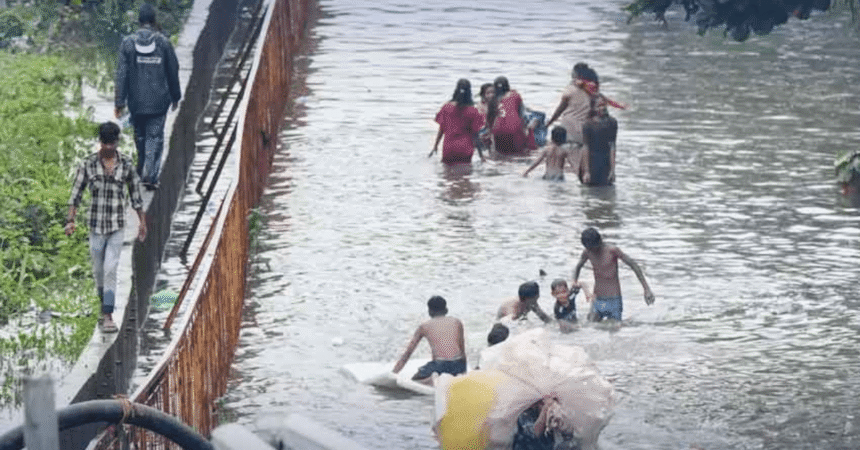Mumbai, India’s bustling financial capital, is currently grappling with unprecedented flooding due to relentless monsoon rains that have inundated the city. As of Thursday, at least four fatalities have been reported, with countless residents facing disruptions to their daily lives. The situation has prompted a citywide red alert as authorities scramble to respond to the crisis.
The Scale of the Downpour
The India Meteorological Department (IMD) reported that certain areas of Mumbai received an astonishing 275 mm (11 inches) of rain within a short span on Wednesday evening. Such intense rainfall is uncommon and has led to widespread waterlogging, crippling the city’s infrastructure. Roads that typically teem with life are now transformed into rivers, with vehicles submerged and passengers stranded.
Drone footage and social media posts depict harrowing scenes of chaos. Cars are stuck in floodwaters, with many drivers remaining trapped inside, awaiting rescue. Streets that usually facilitate the movement of millions are now impassable, creating a humanitarian crisis as commuters struggle to return home.
Transportation Woes
The heavy rains have wreaked havoc on Mumbai’s already strained transportation system. Major highways, arterial roads, and suburban train services—crucial for daily commuters—have faced significant disruptions. Many trains were delayed or canceled, leaving commuters, who rely on this service, stranded for hours. Reports of passengers being stuck on trains for extended periods have emerged, further highlighting the gravity of the situation.
Traffic jams have stretched for miles, causing frustration and despair among those trying to navigate the flooded streets. Public transport services, including buses and auto-rickshaws, have also faced operational challenges, forcing many to seek alternative, often unsafe, means of transportation. The chaos on the roads has compounded the difficulties faced by residents trying to evacuate to safer areas.
Human Tragedy
Amidst the logistical challenges, the human toll of the disaster is profound. Officials confirmed that at least four people have died from rain-related incidents, including cases of drowning and electrocution. These tragedies emphasize the urgent need for effective emergency response measures and community preparedness.
In addition to the loss of life, many families have been displaced due to flooding. Relief efforts are currently underway, with local authorities coordinating with NGOs to provide immediate assistance. Temporary shelters are being established to accommodate those who have lost their homes or have been evacuated from flood-prone areas.
Government Response and Warnings
In light of the ongoing crisis, the Mumbai Municipal Corporation has declared a citywide red alert. Authorities are urging residents to stay indoors unless absolutely necessary, emphasizing the importance of safety during such extreme weather conditions. Schools and colleges have been closed as a precautionary measure, and public gatherings are discouraged.
Fishermen along the coastline have also been warned to stay ashore until the weather improves. The heavy seas and rough weather conditions pose significant risks to maritime activities. Local fishermen, a vital part of the community, are being advised to prioritize safety during this tumultuous period.
As part of the emergency response, officials are mobilizing resources to address the immediate needs of those affected. Emergency response teams have been deployed to assist with evacuations, provide medical care, and distribute food and essential supplies to those in need. The focus remains on ensuring the safety and well-being of residents as the city navigates this unprecedented situation.
The Monsoon: Blessing or Curse?
The monsoon season in India, typically spanning from June to September, is crucial for replenishing water supplies and supporting agriculture. However, this year has seen an unusual pattern, with the monsoon retreating later than usual. While these rains can replenish reservoirs and aquifers, they can also lead to severe flooding, particularly in urban areas like Mumbai, which struggle with inadequate drainage systems.
The delayed monsoon has raised concerns among farmers as well. While some areas may benefit from the additional rainfall, others have reported damage to crops due to waterlogging and flooding. The delicate balance between the need for rain and the risk of flooding poses ongoing challenges for both urban and rural communities.
Climate Change and Urban Vulnerability
The intensity of recent weather events raises important questions about climate change and its impact on urban areas. Mumbai, with its dense population and sprawling infrastructure, is particularly vulnerable to the effects of climate change. Rising sea levels and increased rainfall intensity are becoming more common, creating urgent needs for better urban planning and disaster preparedness.
City planners and policymakers are now faced with the challenge of developing strategies that enhance resilience against future climate-related disasters. This includes improving drainage systems, investing in green infrastructure, and developing policies that prioritize sustainable land use. The goal is to mitigate the risks posed by extreme weather while also addressing the underlying vulnerabilities in urban infrastructure.
Community Resilience and Solidarity
Despite the overwhelming challenges, the spirit of resilience among Mumbai’s residents is inspiring. Community organizations and local volunteers have mobilized to help those in need. Relief initiatives, such as food and clothing drives, have gained momentum, showcasing the solidarity and compassion of the city’s diverse population.
Social media platforms have played a crucial role in organizing relief efforts, with residents sharing information about safe zones, available resources, and assistance for those affected by the flooding. This grassroots mobilization highlights the importance of community in times of crisis, reinforcing the idea that collective action can make a significant difference.
The Role of Technology in Disaster Management
The ongoing crisis has underscored the potential role of technology in improving disaster management. With advancements in communication and data analytics, authorities can better monitor weather patterns and disseminate timely information to the public. Real-time updates about flooding, road conditions, and safety advisories can empower residents to make informed decisions during emergencies.
Furthermore, the use of drone technology has proven beneficial in assessing damage and identifying areas that require immediate assistance. Drones can provide aerial views of flooded regions, enabling emergency responders to plan their actions effectively and prioritize areas that need urgent intervention.
Looking Ahead: Preparing for the Future
As the rains continue, the immediate priority remains on ensuring the safety of residents and providing relief to those affected. Meteorologists are closely monitoring weather patterns, and updates will be crucial in helping authorities and residents prepare for any further rainfall. Continuous assessments will be necessary to gauge the effectiveness of response measures and to adjust strategies as needed.
In the long term, addressing the infrastructure vulnerabilities exposed by this disaster will be essential. Policymakers, urban planners, and the community must collaborate to create a more resilient city that can withstand the impacts of climate change and extreme weather events. This collaboration will require investment in infrastructure improvements, community engagement, and long-term planning.
Long-Term Solutions and Infrastructure Investment
As Mumbai navigates the current crisis, discussions about long-term solutions for flood management and urban resilience are becoming increasingly urgent. Effective drainage systems are crucial to mitigating the impact of heavy rainfall. Investments in expanding and upgrading existing drainage infrastructure can help prevent future flooding incidents.
Additionally, green infrastructure, such as rain gardens and permeable pavements, can play a vital role in absorbing rainwater and reducing surface runoff. These sustainable approaches not only manage stormwater but also enhance urban biodiversity and improve air quality.
The collaboration between government agencies, private organizations, and local communities will be pivotal in developing and implementing these solutions. Engaging stakeholders at all levels can foster a sense of ownership and responsibility, ensuring that the strategies developed are both effective and sustainable.
Public Awareness and Education
Public awareness and education are crucial components in building resilience against flooding and other climate-related challenges. Communities need to be informed about the risks associated with extreme weather events and the importance of preparedness. Educational campaigns can empower residents to take proactive measures, such as creating emergency plans, securing their properties, and knowing evacuation routes.
Local governments and NGOs can play a pivotal role in facilitating these educational initiatives, ensuring that residents understand the resources available to them during emergencies. Community workshops, informational materials, and online resources can all contribute to a well-informed populace that is better equipped to respond to disasters.
A Call for Action
The recent torrential rains in Mumbai have laid bare the vulnerabilities of urban infrastructure in the face of climate change. As the city navigates the immediate challenges posed by flooding, it is imperative to look toward the future. Comprehensive planning, community engagement, and investments in sustainable infrastructure will be essential in building a resilient Mumbai capable of withstanding the impacts of extreme weather.
The tragic loss of life and disruption of daily life must serve as a wake-up call for policymakers, urban planners, and citizens alike. Collaborative efforts, innovative solutions, and a commitment to sustainability can pave the way for a safer, more resilient future for Mumbai.
#MumbaiFloods #HeavyRain #Monsoon2024 #WeatherAlert #India







